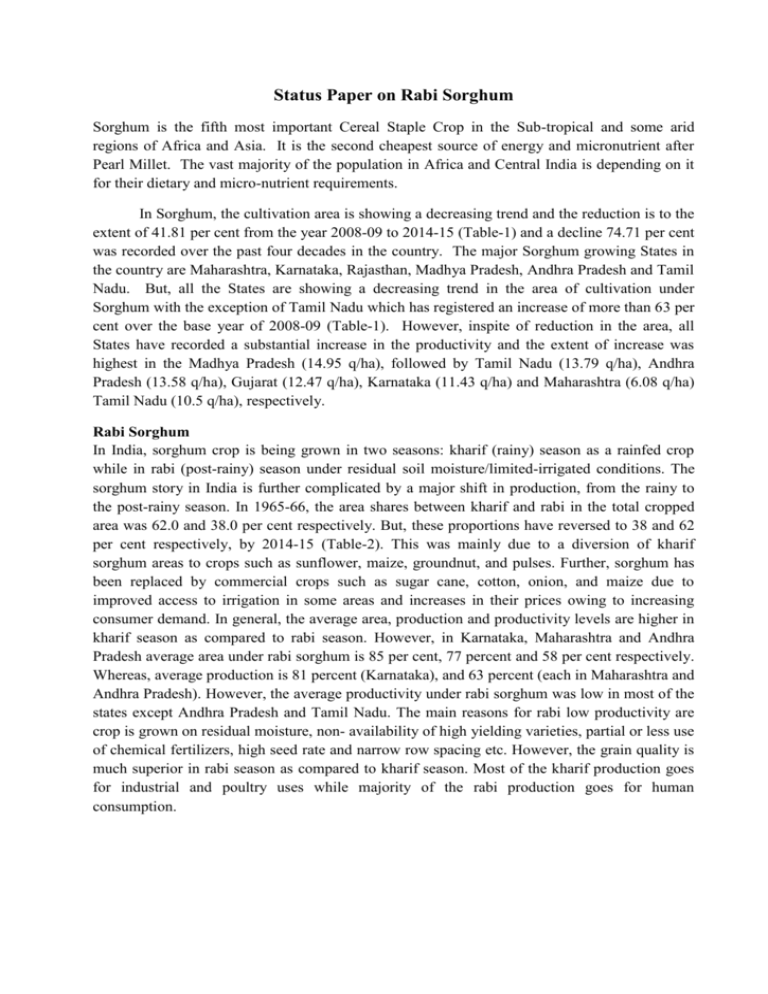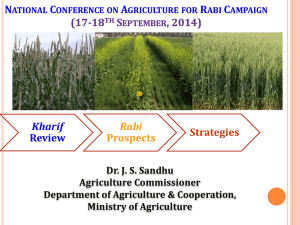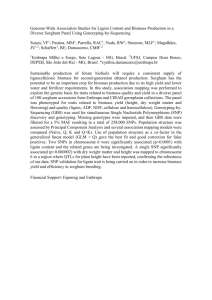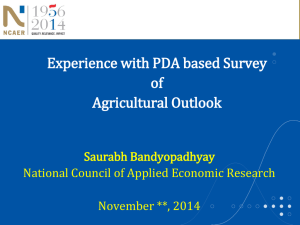Status Paper on Rabi Sorghum. Dated: 13-07-2015
advertisement

Status Paper on Rabi Sorghum Sorghum is the fifth most important Cereal Staple Crop in the Sub-tropical and some arid regions of Africa and Asia. It is the second cheapest source of energy and micronutrient after Pearl Millet. The vast majority of the population in Africa and Central India is depending on it for their dietary and micro-nutrient requirements. In Sorghum, the cultivation area is showing a decreasing trend and the reduction is to the extent of 41.81 per cent from the year 2008-09 to 2014-15 (Table-1) and a decline 74.71 per cent was recorded over the past four decades in the country. The major Sorghum growing States in the country are Maharashtra, Karnataka, Rajasthan, Madhya Pradesh, Andhra Pradesh and Tamil Nadu. But, all the States are showing a decreasing trend in the area of cultivation under Sorghum with the exception of Tamil Nadu which has registered an increase of more than 63 per cent over the base year of 2008-09 (Table-1). However, inspite of reduction in the area, all States have recorded a substantial increase in the productivity and the extent of increase was highest in the Madhya Pradesh (14.95 q/ha), followed by Tamil Nadu (13.79 q/ha), Andhra Pradesh (13.58 q/ha), Gujarat (12.47 q/ha), Karnataka (11.43 q/ha) and Maharashtra (6.08 q/ha) Tamil Nadu (10.5 q/ha), respectively. Rabi Sorghum In India, sorghum crop is being grown in two seasons: kharif (rainy) season as a rainfed crop while in rabi (post-rainy) season under residual soil moisture/limited-irrigated conditions. The sorghum story in India is further complicated by a major shift in production, from the rainy to the post-rainy season. In 1965-66, the area shares between kharif and rabi in the total cropped area was 62.0 and 38.0 per cent respectively. But, these proportions have reversed to 38 and 62 per cent respectively, by 2014-15 (Table-2). This was mainly due to a diversion of kharif sorghum areas to crops such as sunflower, maize, groundnut, and pulses. Further, sorghum has been replaced by commercial crops such as sugar cane, cotton, onion, and maize due to improved access to irrigation in some areas and increases in their prices owing to increasing consumer demand. In general, the average area, production and productivity levels are higher in kharif season as compared to rabi season. However, in Karnataka, Maharashtra and Andhra Pradesh average area under rabi sorghum is 85 per cent, 77 percent and 58 per cent respectively. Whereas, average production is 81 percent (Karnataka), and 63 percent (each in Maharashtra and Andhra Pradesh). However, the average productivity under rabi sorghum was low in most of the states except Andhra Pradesh and Tamil Nadu. The main reasons for rabi low productivity are crop is grown on residual moisture, non- availability of high yielding varieties, partial or less use of chemical fertilizers, high seed rate and narrow row spacing etc. However, the grain quality is much superior in rabi season as compared to kharif season. Most of the kharif production goes for industrial and poultry uses while majority of the rabi production goes for human consumption. All India Area, Production and Yield of Rabi Sorghum from 2008-09 to 2014-15 5000 4500 4000 3500 Area 3000 Production 2500 Yield 2000 1500 1000 500 0 2008-09 2009-10 2010-11 2011-12 2012-13 2013-14 2014-15 Strategies for enhancing area under Rabi sorghum Efforts to increase productivity in case of rabi sorghum would help in bringing down the prices of rabi sorghum and make it affordable for lower income consumers as they cannot afford to buy rabi sorghum due to its high price. For rabi sorghum, besides targeting increased yields, targeting water use efficiency, reducing drought risk and superior quality should be an over riding goal to continue its usage as a preferred staple in the crop growing area and also other regions. Based on data available, nearly 40 per cent of sorghum cropped area in the country has been covered by high yielding varieties and hybrids. But, states like Rajasthan, Madhya Pradesh and Tamil Nadu, Andhra Pradesh and have exhibited high coverage of hybrids in the kharif season ranging from 100 - 63 per cent, whereas Andhra Pradesh, Karnataka and Maharashtra states showed less than 37 per cent of cropped area coverage under hybrids in kharif season (Table-3). The crop production and productivity in the country has stabilized to some extent because of increasing rates of adoption of hybrids. However, the adoption of improved cultivars in the country was much conspicuous in kharif season as compared to rabi season. Overall, the increased adoption of improved cultivars clearly pushed the average yields in the country over the last four decades. The recent crop trends in India have indicated that there is a steep decline in sorghum cropped area. However, sorghum continues to be the main staple food for poor and marginal farmers of India. The crop has huge potential and also been identified as one among the climate resilient crops that can adapt quickly under changing climatic conditions. The kharif season crop production has declined despite successful crop improvement efforts by both public and private sectors due to sharp fall in cropped area. The post-rainy (rabi) season production pattern was relative stable even though there is a slight deviation in crop sown area. Future prioritization of sorghum research In addition to the biotic and abiotic challenges, presumed climate change affects the sorghum area and its importance globally. Climate change will modify the length of growing period and increases the predicted temperatures across the sorghum growing regions. So, more thrust is need on development of drought resistant and heat tolerant cultivars by using modern biotechnology tools. Similarly, emphasis should be given for improvement of post-rainy vintages for increasing the adoption rates in the country. Sorghum is widely cultivated during the rainy (kharif) and post-rainy (rabi) seasons in central and western Maharashtra, northern Karnataka, Andhra Pradesh, and Tamil Nadu. Besides, sorghum is an important feed for livestock, especially in the dry months when other feed resources are in short supply. The sorghum grain produced during the post rainy season (rabi) is from local and improved landraces of superior quality (bold, white, and with a sweeter taste) and hence preferred for human consumption. In contrast, the sorghum produced in the rainy season (kharif) is from hybrids but is less preferred for human consumption. About 50% of the kharif produce goes into alternative uses such as poultry feed, alcohol, and animal feed, while rabi sorghum is exclusively used as food. The advantages of growing this crop is that it need less external input, drought tolerant, sturdy, short to medium duration, low labour utilising, resistant to pests and diseases, and meet food, nutrition, and fodder requirements. Second, sorghum is C4 crop having carbon fixing properties. Given moisture stress, sorghum is the best alternative for extreme weather conditions and well suited to drought-prone regions. Third, an important feature of sorghum is its nutritional quality. Sorghum is the richest source of nutrition, especially iron, calcium, and zinc, among cereals and can provide all the nutrients at the least cost compared to wheat and rice. Fourth, the crop residue forms an important component of feed for livestock. Despite these advantages, a lack of economic incentives in the face of declining food consumption of these crops has relegated sorghum to the status of inferior crop.




